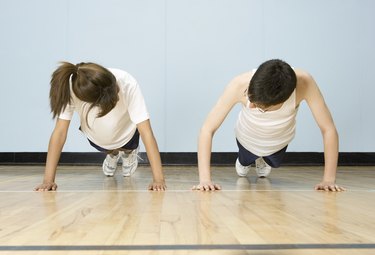
A 14-year-old has school, games, friends, chores and after-school activities to worry about — how many push-ups he can do isn't usually a primary focus. However, if the teen wants to know how he stands up to his peers or how his commitment to sports practice is paying off, it's fun to test push-up prowess.
The average number of push-ups a 14-year-old should be able to do varies by gender and stage of development. Some 14-year-olds may have reached puberty and actually are starting to pile on muscle, says Teens Health; others may still lack enough growth hormone to have the upper-body strength to reach full push-up potential.
Video of the Day
Video of the Day
To rate an average score in the push-up department, though, a boy should be able to pump out 24 reps, and a girl, 10, using a three-second pace — no stopping.
Tip
The number of push-ups a 14-year-old should be able to do varies according to gender and stage of development.
Read more: Proper Push-Up Technique
Youth Fitness Test Standards
Most "fitness tests" that provide norms for push-ups and other qualities, such as muscular strength and endurance, are based on people 20 years and older. Standards and averages for children and adolescents are much harder to pin down because these populations vary so much in development and ability.
The Presidential Youth Fitness Program is applied in many schools across the United States. It's designed to evaluate the state of physical fitness in youth aged 6 to 17. In addition to a push-up test, it also includes other markers such as a pull-up/flex arm hang test, a sit-up test, shuttle runs and a sit-and-reach test.
In the now-defunct President's Challenge in terms of push-ups, to make it to the 85th percentile — meaning that you performed better than 85 percent of the rest of the people your age who took the test — a 14-year-old boy had to do 40 push-ups and a girl had to do 20.
No time limit was given, but the push-ups were done according to a metronome that set the pace at three seconds per push-up. When the student couldn't do anymore, or couldn't keep pace, the test ended.
For a 14-year-old to be in the 50th percentile, a boy had to perform 24 push-ups and a girl, 10. A score of just 3 for a girl or 11 for a boy was considered poor and put them in the 10th percentile.
Percentiles aren't considered at all at the Cooper Institute's FitnessGram. They believe that pitting students against each other is counter-productive to the ultimate goal of healthy fitness levels.
Read more: What Are the Benefits of Push-Ups?
Use the Proper Form
Any attempt at a push-up doesn't count. You must maintain good form for each push-up for it to be considered valid.
You start in a plank position, balanced on your toes and hands. Your feet can be about 2 to 4 inches apart, with the legs straight. Fingers should be pointed forward and the hands flat. Hiking or sagging of the hips invalidates the push-up.
Another person sits in front of the 14-year-old doing the push-ups and hovers her hands parallel to the floor at a place equal to a 90-degree bend in the exerciser's elbows. The person doing the push-ups must lower to this point for the push-up to count.